Abstract
We report on a pilot study to assess the effects of low intensity war in Nicaragua on the health of the civilian population. The study compared data from two regions in Nicaragua, one in an area of intense conflict, the other further removed from the war's violence. Information was obtained from a questionnaire administered to female heads of randomly selected households; structured interviews with community leaders and health workers; group discussions with community residents; and a review of regional and municipal death records. Height and mid-upper arm circumference of children were measured, and immunization records reviewed. The war has had a serious negative effect on the lives of the civilian population in both the war zone and the non-war zone, with the effects most severe in the war zone. In both communities, over half of the respondents reported the death of a friend or relative. In the war zone community, over one-fourth of respondents reported attacks on family members in non-combat situations around their homes. Death by firearms was the leading cause of death in persons over age 6 in the war zone. Vaccination coverage, nutritional indices, and familial disruption were worse in the war zone community. The findings suggest that continued funding of the Nicaraguan contra forces by the United States may be harming the ostensible beneficiaries of that policy, and that use of such low intensity conflict as a foreign policy tool should be questioned.
Full text
PDF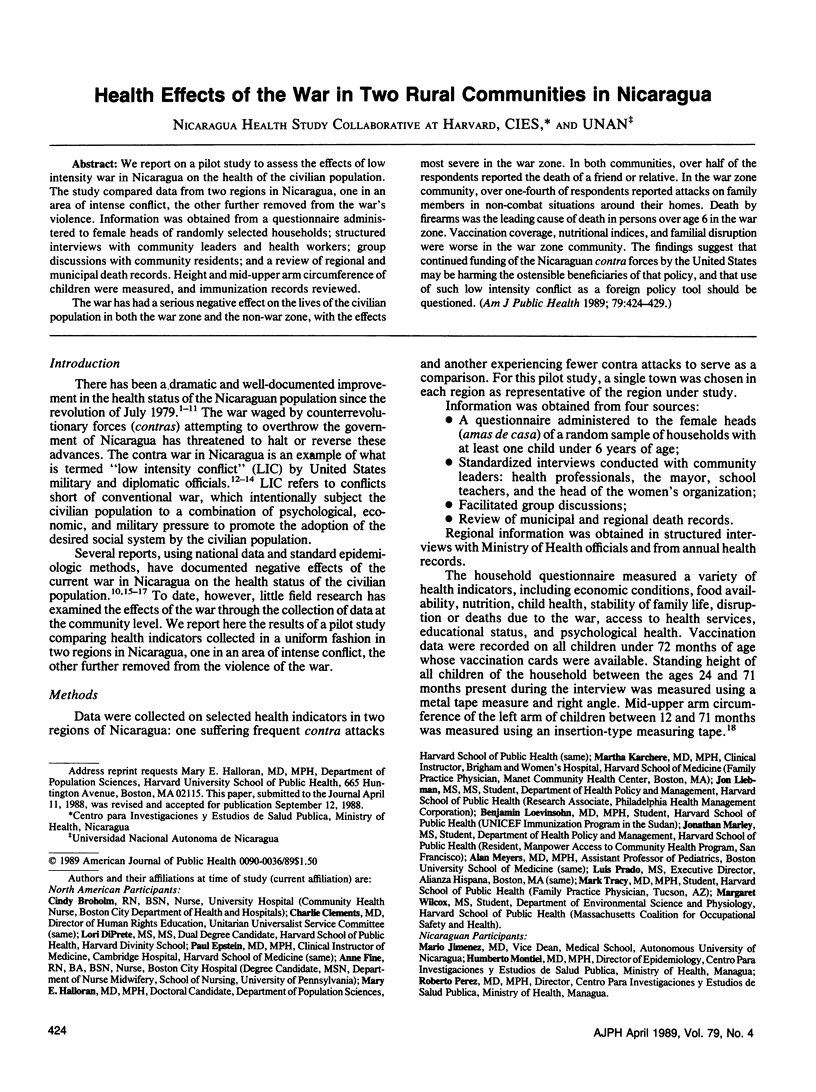
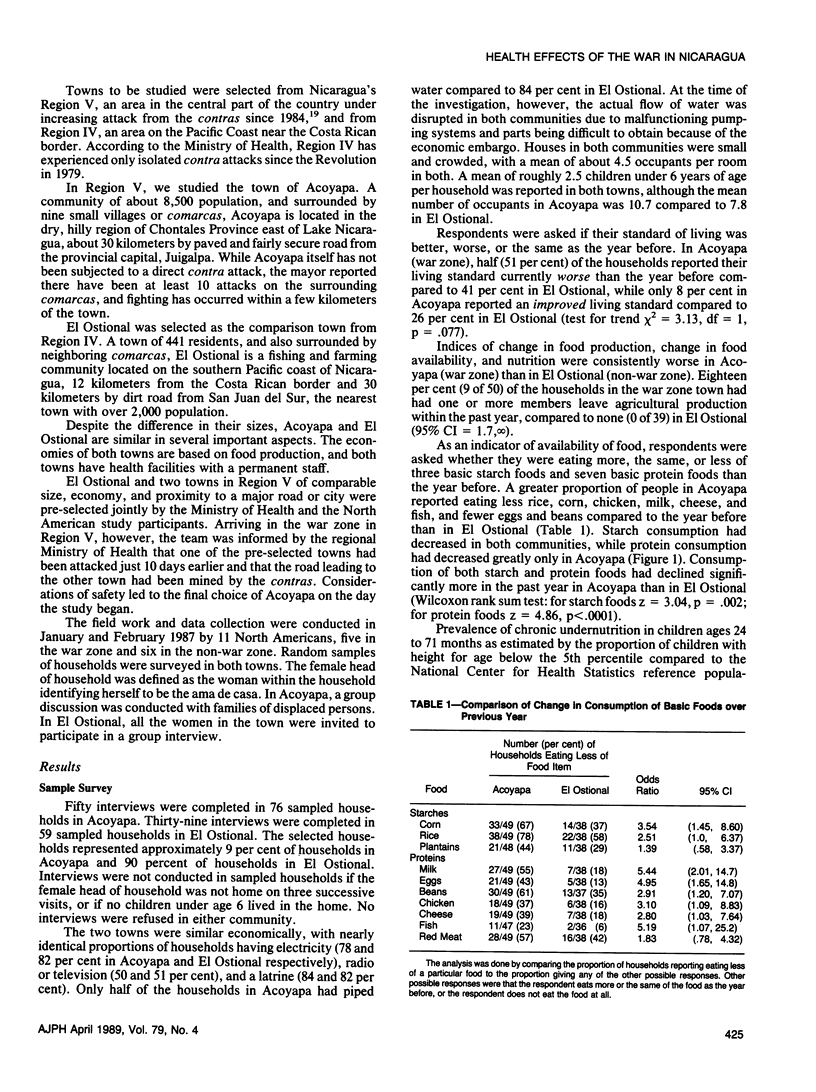
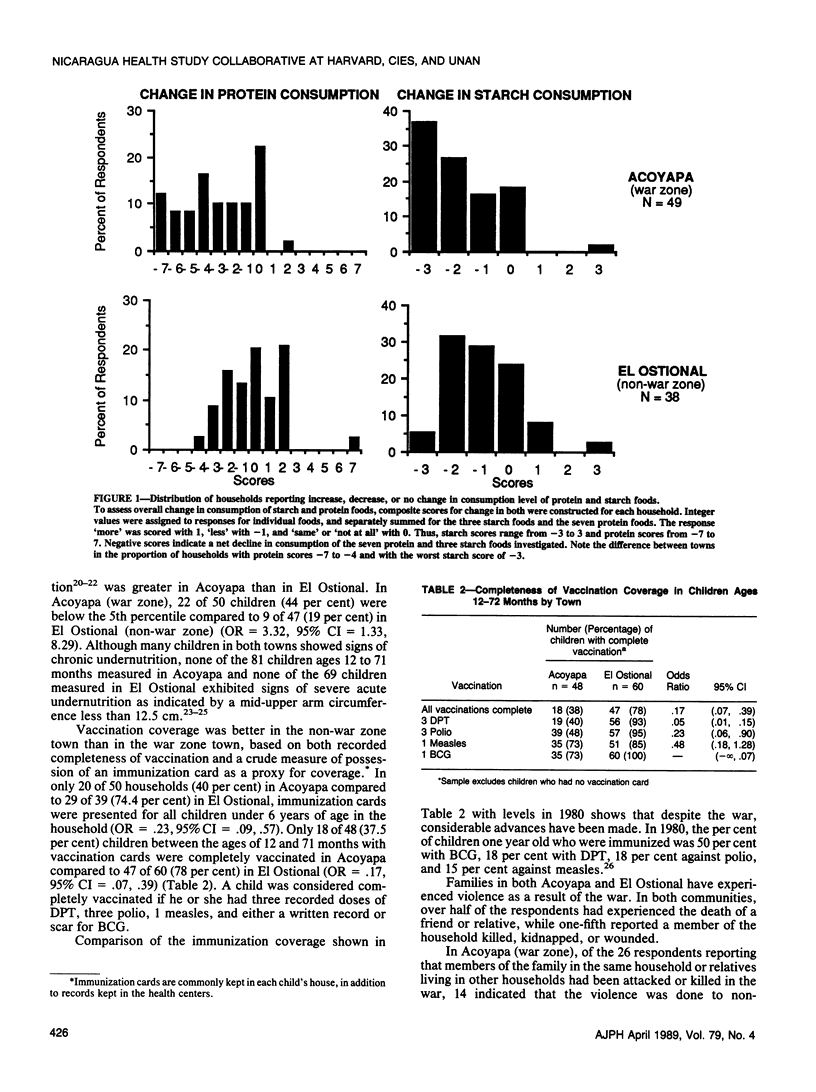
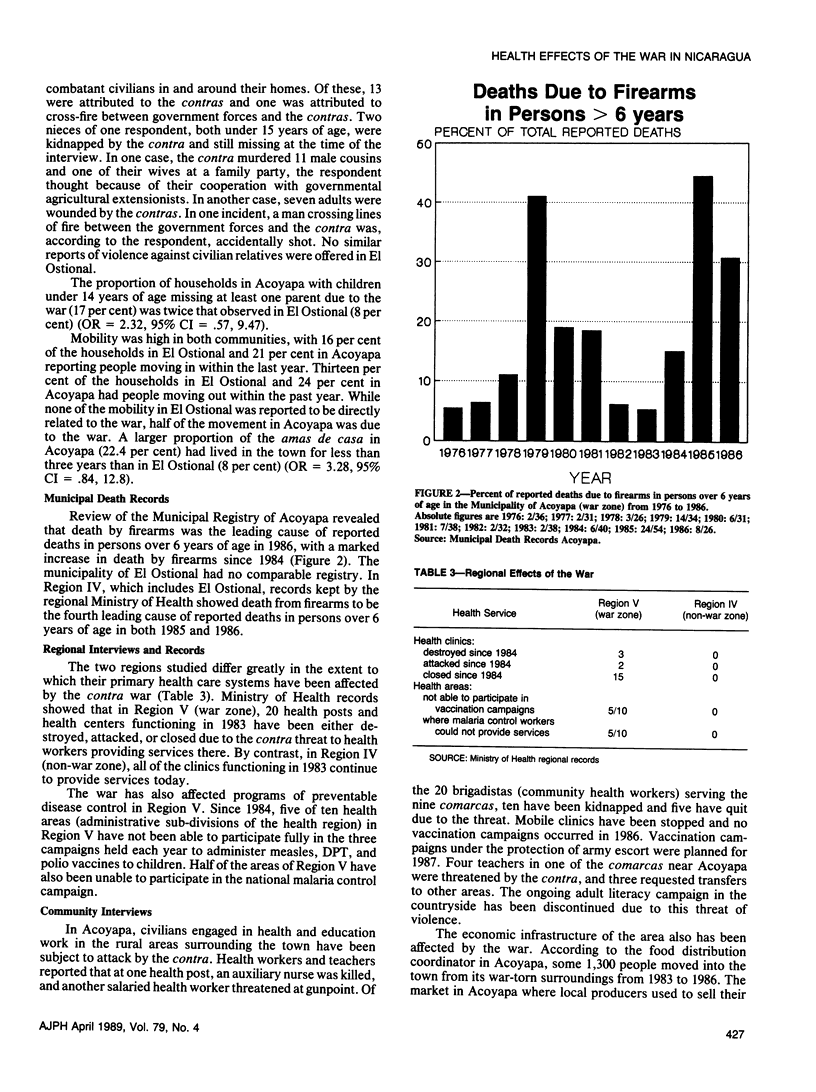
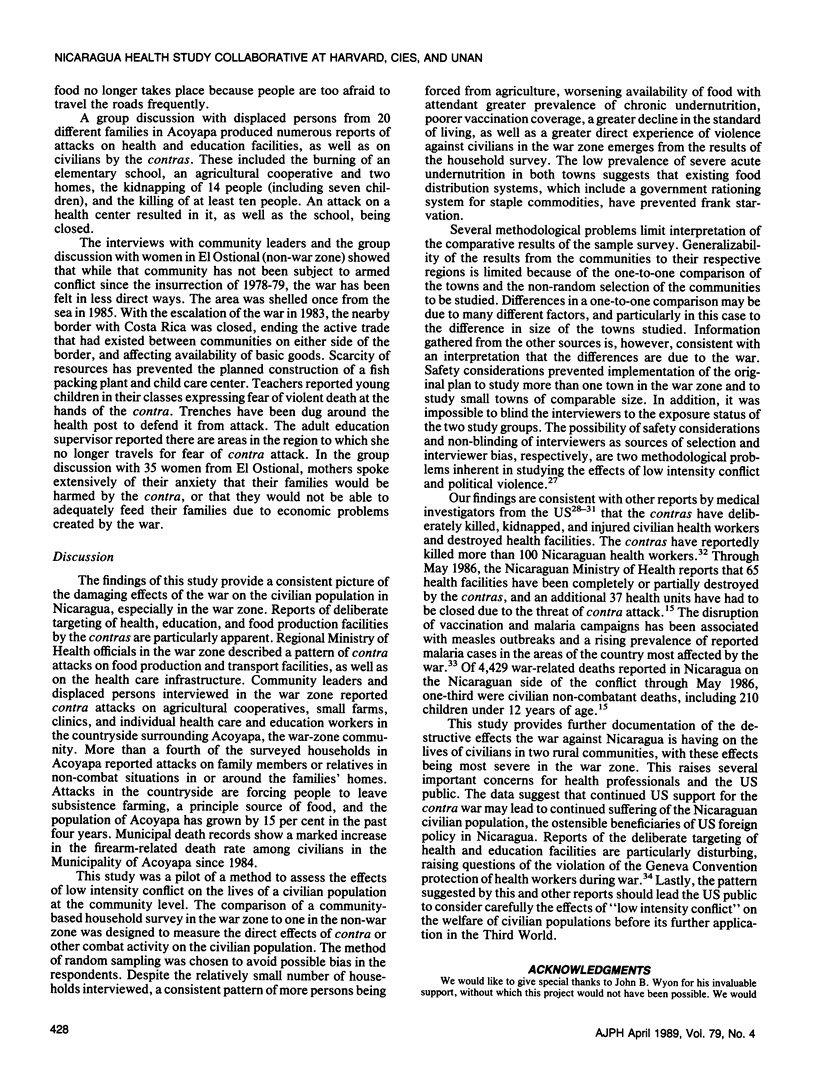
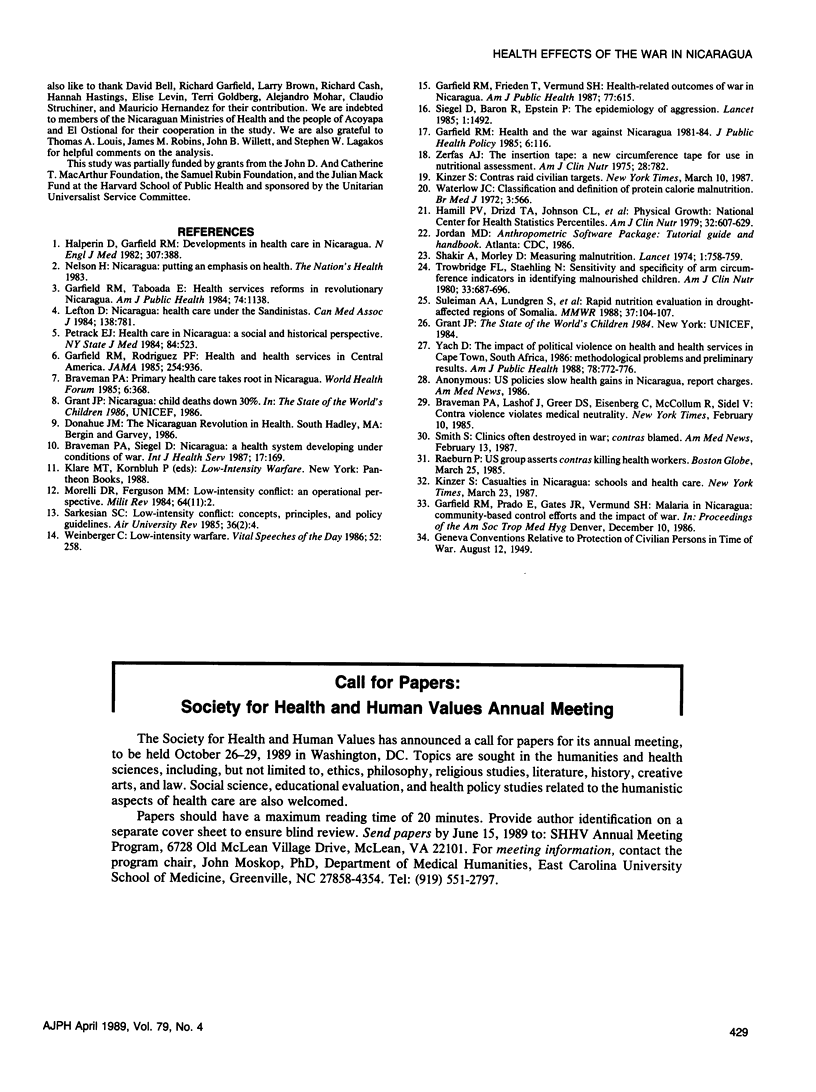
Selected References
These references are in PubMed. This may not be the complete list of references from this article.
- Braveman P., Siegel D. Nicaragua: a health system developing under conditions of war. Int J Health Serv. 1987;17(1):169–178. doi: 10.2190/DB43-MWPL-2V12-WGXY. [DOI] [PubMed] [Google Scholar]
- Brunswick M., June C. H., Finkelman F. D., Dintzis H. M., Inman J. K., Mond J. J. Surface immunoglobulin-mediated B-cell activation in the absence of detectable elevations in intracellular ionized calcium: a model for T-cell-independent B-cell activation. Proc Natl Acad Sci U S A. 1989 Sep;86(17):6724–6728. doi: 10.1073/pnas.86.17.6724. [DOI] [PMC free article] [PubMed] [Google Scholar]
- Centers for Disease Control (CDC) Rapid nutrition evaluation in drought-affected regions of Somalia--1987. MMWR Morb Mortal Wkly Rep. 1988 Feb 26;37(7):104–107. [PubMed] [Google Scholar]
- Garfield R. M., Frieden T., Vermund S. H. Health-related outcomes of war in Nicaragua. Am J Public Health. 1987 May;77(5):615–618. doi: 10.2105/ajph.77.5.615. [DOI] [PMC free article] [PubMed] [Google Scholar]
- Garfield R. M. Health and the war against Nicaragua, 1981-84. J Public Health Policy. 1985 Mar;6(1):116–131. [PubMed] [Google Scholar]
- Garfield R. M., Rodriguez P. F. Health and health services in Central America. JAMA. 1985 Aug 16;254(7):936–943. [PubMed] [Google Scholar]
- Garfield R. M., Taboada E. Health services reforms in revolutionary Nicaragua. Am J Public Health. 1984 Oct;74(10):1138–1144. doi: 10.2105/ajph.74.10.1138. [DOI] [PMC free article] [PubMed] [Google Scholar]
- Halperin D. C., Garfield R. Developments in health care in Nicaragua. N Engl J Med. 1982 Aug 5;307(6):388–392. doi: 10.1056/NEJM198208053070634. [DOI] [PubMed] [Google Scholar]
- Hamill P. V., Drizd T. A., Johnson C. L., Reed R. B., Roche A. F., Moore W. M. Physical growth: National Center for Health Statistics percentiles. Am J Clin Nutr. 1979 Mar;32(3):607–629. doi: 10.1093/ajcn/32.3.607. [DOI] [PubMed] [Google Scholar]
- Lefton D. Nicaragua: health care under the Sandinistas. Can Med Assoc J. 1984 Mar 15;130(6):781–784. [PMC free article] [PubMed] [Google Scholar]
- Petrack E. M. Health care in Nicaragua: a social and historical perspective. N Y State J Med. 1984 Oct;84(10):523–525. [PubMed] [Google Scholar]
- Shakir A., Morley D. Letter: Measuring malnutrition. Lancet. 1974 Apr 20;1(7860):758–759. doi: 10.1016/s0140-6736(74)92987-0. [DOI] [PubMed] [Google Scholar]
- Siegel D., Baron R., Epstein P. The epidemiology of aggression. Health consequences of war in Nicaragua. Lancet. 1985 Jun 29;1(8444):1492–1493. doi: 10.1016/s0140-6736(85)92262-7. [DOI] [PubMed] [Google Scholar]
- Trowbridge F. L., Staehling N. Sensitivity and specificity of arm circumference indicators in identifying malnourished children. Am J Clin Nutr. 1980 Mar;33(3):687–696. doi: 10.1093/ajcn/33.3.687. [DOI] [PubMed] [Google Scholar]
- Waterlow J. C. Classification and definition of protein-calorie malnutrition. Br Med J. 1972 Sep 2;3(5826):566–569. doi: 10.1136/bmj.3.5826.566. [DOI] [PMC free article] [PubMed] [Google Scholar]
- Yach D. The impact of political violence on health and health services in Cape Town, South Africa, 1986: methodological problems and preliminary results. Am J Public Health. 1988 Jul;78(7):772–776. doi: 10.2105/ajph.78.7.772. [DOI] [PMC free article] [PubMed] [Google Scholar]
- Zerfas A. J. The insertion tape: a new circumference tape for use in nutritional assessment. Am J Clin Nutr. 1975 Jul;28(7):782–787. doi: 10.1093/ajcn/28.7.782. [DOI] [PubMed] [Google Scholar]


